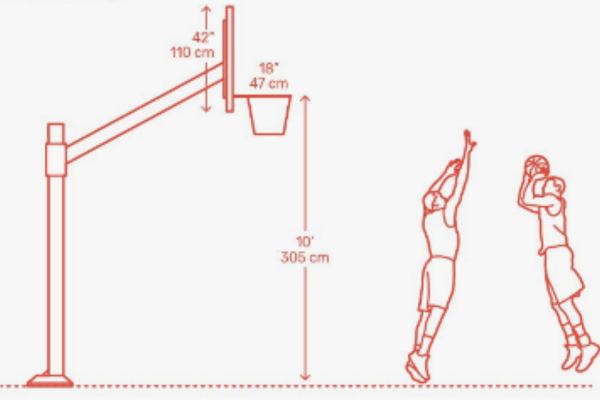Basketball—America’s homegrown sport—has become a global phenomenon, played and loved across continents. From neighborhood courts to the Olympic Games, basketball captures attention through fast-paced action, impressive athleticism, and team spirit.
But how did the basketball hoop evolve to what we know today? And why is the height exactly 10 feet? In this guide, we’ll take you through the evolution of the basketball hoop, from its humble beginnings to its modern design—and everything in between.

Basketball was invented in the winter of 1891-1892 by Dr. James Naismith, a physical education instructor at the International YMCA Training School in Springfield, Massachusetts. Tasked with creating an indoor activity suitable for snowy winters, Naismith devised a game involving a soccer ball and two peach baskets nailed to a railing, ten feet off the ground.
The idea was simple: toss the ball into the opposing team’s basket. Though primitive, the game quickly gained traction and began to evolve. The 10-foot height of the original balcony railing became the standard hoop height—a rule that remains unchanged to this day.
Who Was James Naismith?
James Naismith was 31 years old when he invented basketball. Working under Dr. Luther Gulick at the International YMCA Training School in Springfield, Massachusetts, he was challenged to create a game that was:
- Safe for indoor play
- Involving physical exercise but less violent than football
- Easy to learn but with enough depth to be interesting
With a deep understanding of sports and a creative mind, Naismith began blending concepts from various athletic games to build something entirely new. He borrowed goal lines from lacrosse, passing from football, non-contact rules from baseball, and the jump ball from rugby to form the foundation of basketball.
Using two peach baskets nailed to a balcony railing 10 feet above the floor, Naismith introduced the first version of the game to a class of 18 students. He divided them into two teams of nine players each and laid out the original 13 rules of basketball—many of which still influence the game today.
His creation quickly gained popularity, sparking the evolution of basketball from a simple indoor activity into one of the most beloved sports worldwide.
How Basketball Was Played (Then vs. Now)
Early Gameplay
Basketball looked very different in its early years:
- Peach baskets were used instead of hoops. Initially, they had closed bottoms, so the ball had to be retrieved after every score.
- The baskets were nailed to the railing of balconies, which led to interference from spectators.
- Backboards weren’t introduced until 1906.
- Players couldn’t dribble; they could only pass or shoot.
- Teams could have varying numbers of players—there was no standard until 1897.
- Only Naismith’s 13 original rules governed the game.
Modern Gameplay
As the game matured, so did the rules and equipment:
- The hoop now measures 10 feet from the ground and has a diameter of 18 inches.
- Backboards are made of fiberglass or wood and measure 6 feet wide by 4 feet high.
- Dribbling became a crucial part of the game.
- Team size was standardized to five players per side.
- Only nine of the original 13 rules are still followed today, with hundreds more added since.
The Evolution of the Basketball Hoop
1890s – Peach Baskets and Railings
The first basketball hoops were literal peach baskets mounted on railings 10 feet high. Players had to climb ladders to retrieve the ball after every basket. In 1893, backboards were added, and in time, the bottoms of the baskets were removed to speed up play.
1925 – Standardization Begins
By 1925, metal rims and nets became the norm. The invention of nylon in 1912 led to the use of netting, and backboards became standard equipment in organized games.
Modern Era – High-Tech and Dunk-Ready
The NBA set the modern standards for the hoop:
- Rim Height: 10 feet from the ground
- Rim Diameter: 18 inches
- Backboard Size: 6 feet by 4 feet
- Net Length: 15 to 18 inches, usually made of nylon
- Net Alternatives: Chain nets used in outdoor settings
In 1978, the breakaway rim was introduced to protect the hoop and backboard from damage due to forceful dunks. This innovation made the game safer and more dynamic.
FAQs About Basketball Hoop Height

How high is a standard basketball hoop?
A standard basketball hoop is 10 feet (3.05 meters) above the playing surface. This height has remained unchanged since the game’s invention in 1891.
Why did James Naismith choose 10 feet?
It wasn’t a deliberate decision—Naismith hung the peach baskets on the balcony of the gym, which happened to be 10 feet high. The height stuck and became a lasting standard.
Is the hoop height the same in all levels of play?
Yes, from high school to the NBA and even the Olympics, the standard hoop height remains 10 feet. However, for youth leagues, adjustable hoops may be used at lower heights to accommodate younger players.
What is the diameter of a basketball hoop?
The rim of a basketball hoop has an 18-inch (45.72 cm) diameter. This fits a regulation basketball (around 9.5 inches in diameter) with room to spare for clean shots.
When was the breakaway rim introduced and why?
The breakaway rim was introduced in 1978 to reduce the risk of injuries and equipment damage from slam dunks. It flexes under pressure and then returns to position, preserving the backboard and supporting structure.
Are chain nets still used today?
Yes! Chain nets are often used in outdoor basketball courts for their durability. While not as common in official indoor games, they’re preferred for parks and community hoops.
What are the best in-ground basketball hoops for home use?
The best in-ground basketball hoops for home use are durable, adjustable, and weather-resistant. Look for hoops with a sturdy build, adjustable height, and a reliable breakaway rim for safety and performance.
What are the materials used for modern hoops?
Modern hoops use steel rims, nylon or chain nets, and fiberglass or acrylic backboards. These materials are designed to withstand aggressive play and various weather conditions.
Conclusion

The basketball hoop has come a long way—from peach baskets to breakaway rims. While the materials and structure have changed, one thing has stayed constant: the 10-foot height. These advancements have not only improved gameplay but also ensured durability, safety, and excitement for generations of players and fans.
Whether you’re just shooting around in your driveway or dreaming of the NBA, knowing the history of the hoop adds a whole new layer of appreciation for the game. Don’t miss our essential tips for beginners!
